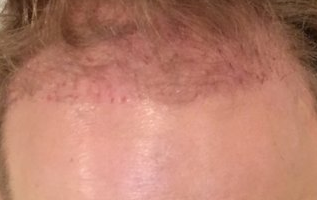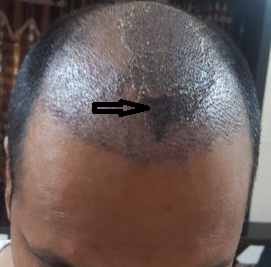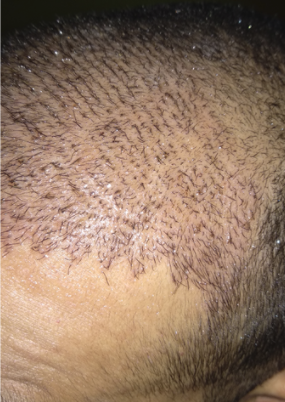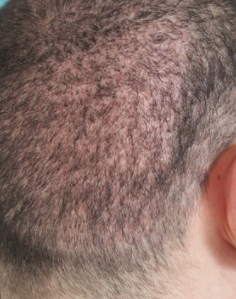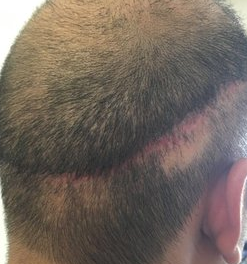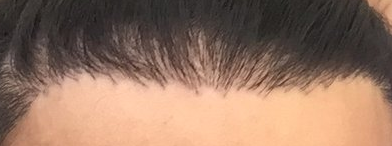I am 33 years old and I have been on Finasteride since 2006 (I took a 10 month break in 2009) and have had great success. In the last 10 months, I have been losing ground though. My hair has started thinning a lot as the result of two massive sheds. I was wondering how you go about assessing whether an increase in dose is appropriate when Finasteride starts to lose effectiveness? I have also been looking at Rogaine foam as an option — but as I am constantly traveling for work, pills are much easier to fit into my routine.
You can try to increase the Finasteride dose and see if that helps. I tend to view the use of Finasateride as a tug of war – the genes and the stressors on your life pulling on one side, and the drug Finasteride pulling on the other side. Maybe an increase in Finasteride dose will weigh more on the pulling against the genes and stress side.
My forehead came down about 1cm with 1500 grafts. I am unhappy with the unnatural look, and my skin is elevated and white. I would like to reduce my forehead surgically and reverse the transplant.
This is not an easy assessment without seeing, at the least, a photo. You said the hairline was only lowered about 1cm, so I need to know what it looks like. Also, your comments about the elevated grafts after growth and the white color of the skin is concerning. If the entire area in front of your normal hairline is no more than 2.5 cm, then a hairline lowering procedure may be able to remove the entire transplanted area. You should see a surgeon that offers hairline advancement surgery, and this could be a good solution for you.
I had 4,400 grafts done, and I am terribly scarred with cobblestoning of my skin. I have a heavily scarred recipient and donor area. Can this be reversed?
Unfortunately, the answer here is no. Reversing 4,400 grafts would be an enormous challenge, and it would take far longer to try to reverse it than having it done in the first place. Scalp Micropigmentation may be your only option, but I would have to see you to understand the deformities you are asking about. We have performed Scalp MicroPigmentation in many people with similar problems as you have described, and it works very well (see here: https://scalpmicropigmentation.com/scar-covering/)
The donor area has been significantly impacted by FUE, suggesting that your original donor density was significantly less than what the number of FUE grafts could have supported. Your doctor should have measured your donor area density prior to doing FUE. The limits on FUE is related to your donor density, otherwise it produces significant scarring as this photo shows. If the donor area remains see-through, you should get Scalp Micropigmentation to fill in the missing spaces.
You have had unfortunate severe scarring from a strip surgery. This is easily treatment with Scalp Micropigmentation. It can also be treated with balloon expanders above the wound. Both have their pros and cons that you must learn about.
If you try filling in FUE scars with more hair transplants from the thigh, body, or neck, you will be subject to the limitations of these donor sites. The neck hair is not permanent hair. Additionally, all body hair below the neck has a short growth cycle, and only half of the hairs will be growing at any one time. Filling in FUE scars can be very expensive and not very effective. In my opinion, SMP is the best option.
An FUE is treated just like a regular hair transplant with regard to the recipient area. Both the recipient area and the donor area have wounds that require daily washing with soap and water. The key is to wash off the crusts before they appear. Within 3 days of surgery, you can resume full activities, including heavy exercises if you wish. I generally recommend the use of a sponge to fill with soapy water and to press on the recipient area daily – be sure to never rub the area with the sponge. By repeating this daily, all crusts can be washed off without any fear of losing grafts. If any crusts remain, use a Q-tip and dip it into soapy water, roll it on the crusts, and this will lift them off without dislodging them. I like to see no evidence of any crusting in the recipient or donor area. Proper washing will guarantee this.
Since you did not follow the above routine, you should now leave a shampoo on your scalp for 15 minutes and do this twice a day. Gently massage the grafts; this will loosen them. The crusts will come off after a few days of following this routine.
https://www.ncbi.nlm.nih.gov/pubmed/29310861
J Tissue Viability. 2018 Jan 4. pii: S0965-206X(17)30132-8. doi: 10.1016/j.jtv.2018.01.001. [Epub ahead of print]
Never too old to regenerate? Wound induced hair follicle neogenesis after secondary intention healing in a geriatric patient?
Author information
Abstract
Wound healing is a natural process to restore the structure and function of injured or diseased tissues. Repair of a skin wound usually leads to a scar while regeneration implies fully recovery of function and structure of the damaged tissue. Adult skin wound usually heals with scar while fetal skin heals scarless. Hair regeneration in elderly scalp wound has never been observed. We reported an 80-year-old patient with a large wound on the scalp after excision of a basal cell carcinoma healed by secondary intention wound healing. The patient’s wound healed very well aesthetically. Interestingly, on approximate post wound day 180, a hair was observed to be growing towards the surface and eventually erupted in the center of the wound. The hair remained black at 42-month follow-up. This case demonstrated that neogenesis of hair is possible even in geriatric patient. To the best of our knowledge, this is the first report of hair regrow in human skin after wound healing.
KEYWORDS:
Basal cell carcinoma; Hair follicle; Regeneration; Secondary intention healing
The history following the potential cure for balding is nicely put together here in the link supplied:
I’m 28, hair thinning. I notice my scalp is often really sore for no reason. It feels better if I rub it. Does this have anything to do with my bald spot? Does anyone actually know?
There are folks that sell massages for three times a week for hair loss. They often put on some oils under the guise that it works. I have seen young men pay as much as $500/month for such treatments. They actually may harm you because massages can pull out weak, miniaturized hairs. Even harsh hair brushing can do this.
The problem I see may be more than just missing areas of hair because the hairline is too ‘regular’ and does not reflect a random placement of grafts. Also, the grafts in the frontal hair line are multi-haired grafts when they should be single hairs. A thick 1/4 inch layer of single hair grafts creates a transition zone in front of any thicker hairline, so it does not appear like a ‘line’. Your transplant, is, unfortunately detectable and needs to have a transition zone built in front of the multi-haired grafts, so that nobody can tell you had a hair transplant.

